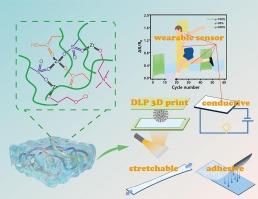A photocurable ultra-tough eutectic gel with coordination crosslinking used for wearable sensors and TENG flexible electrodes
IF 5.8
2区 化学
Q1 POLYMER SCIENCE
引用次数: 0
Abstract
Flexible polymer molecular chains are of great interest to researchers in the field of flexible wearable electronics due to their unrivaled flexibility and ductility. However, achieving high toughness, high elasticity, environmental stability and easy machining of flexible electronic materials remains a challenge. In this study, we present a photocurable eutectic gel mainly composed of DMAPS, AAc, Zr4+ and deep eutectic solvents (DES). Due to the strong coordination between zirconium ions and polymer networks, the gel can be endowed with excellent properties, such as excellent tensile strength (1.14 MPa), low hysteresis (5 kJ·m−3) and good adhesion (above 40 kPa). DES can not only give the gel good electrical conductivity, but also maintain the stability of the gel to ensure that the leakage or volatilization of the solvent will not occur in use. The properties mentioned above allow the gel to achieve a sensitivity factor of up to 1.7 over a small strain range, demonstrating its potential applications in the field of flexible strain sensors and triboelectric flexible electrode materials. What’s more, the gel can be used to prepare complex geometric shapes with high precision through digital light processing (DLP) based 3D printing technology. Therefore, this work introduces a novel approach for the development of highly stable flexible wearable devices, which has the potential to expand the applications of eutectic gels.

用于可穿戴传感器和 TENG 柔性电极的配位交联光固化超韧共晶凝胶
柔性聚合物分子链因其无与伦比的柔韧性和延展性而备受柔性可穿戴电子设备领域研究人员的关注。然而,实现柔性电子材料的高韧性、高弹性、环境稳定性和易加工性仍然是一项挑战。在这项研究中,我们提出了一种主要由 DMAPS、AAc、Zr4+ 和深共晶溶剂(DES)组成的光固化共晶凝胶。由于锆离子与聚合物网络之间的强配位,该凝胶具有优异的性能,如卓越的拉伸强度(1.14 MPa)、低滞后(5 kJ-m-3)和良好的粘附性(40 kPa 以上)。DES 不仅能使凝胶具有良好的导电性,还能保持凝胶的稳定性,确保在使用过程中不会发生溶剂泄漏或挥发。上述特性使凝胶在小应变范围内的灵敏度系数高达 1.7,显示了其在柔性应变传感器和三电柔性电极材料领域的应用潜力。此外,通过基于数字光处理(DLP)的三维打印技术,该凝胶还可用于制备高精度的复杂几何形状。因此,这项工作为开发高稳定性柔性可穿戴设备引入了一种新方法,有望拓展共晶凝胶的应用领域。
本文章由计算机程序翻译,如有差异,请以英文原文为准。
求助全文
约1分钟内获得全文
求助全文
来源期刊

European Polymer Journal
化学-高分子科学
CiteScore
9.90
自引率
10.00%
发文量
691
审稿时长
23 days
期刊介绍:
European Polymer Journal is dedicated to publishing work on fundamental and applied polymer chemistry and macromolecular materials. The journal covers all aspects of polymer synthesis, including polymerization mechanisms and chemical functional transformations, with a focus on novel polymers and the relationships between molecular structure and polymer properties. In addition, we welcome submissions on bio-based or renewable polymers, stimuli-responsive systems and polymer bio-hybrids. European Polymer Journal also publishes research on the biomedical application of polymers, including drug delivery and regenerative medicine. The main scope is covered but not limited to the following core research areas:
Polymer synthesis and functionalization
• Novel synthetic routes for polymerization, functional modification, controlled/living polymerization and precision polymers.
Stimuli-responsive polymers
• Including shape memory and self-healing polymers.
Supramolecular polymers and self-assembly
• Molecular recognition and higher order polymer structures.
Renewable and sustainable polymers
• Bio-based, biodegradable and anti-microbial polymers and polymeric bio-nanocomposites.
Polymers at interfaces and surfaces
• Chemistry and engineering of surfaces with biological relevance, including patterning, antifouling polymers and polymers for membrane applications.
Biomedical applications and nanomedicine
• Polymers for regenerative medicine, drug delivery molecular release and gene therapy
The scope of European Polymer Journal no longer includes Polymer Physics.
 求助内容:
求助内容: 应助结果提醒方式:
应助结果提醒方式:


